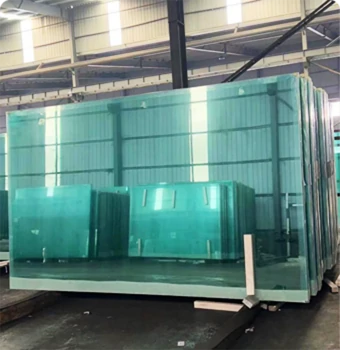Understanding the Composition and Production of Tempered Glass
Tempered glass, also known as toughened glass, is an essential material widely used in various applications due to its enhanced strength and safety features. It is made through a specific heat treatment process that makes it significantly stronger than ordinary glass. This article delves into the components and production process of tempered glass, shedding light on why it is a preferred choice in numerous industries.
Composition of Tempered Glass
The primary raw material for tempered glass is silica sand, which is the base component of glass. Other ingredients such as soda ash, limestone, and various additives are also incorporated to modify the properties of the glass. These components are mixed and melted at high temperatures in a furnace, typically around 1,600°F (870°C).
Once the raw materials are combined and melted, the molten glass is formed into sheets. This can be accomplished through various methods, including the float glass process, where molten glass is floated on a bed of molten tin to create a uniform thickness. The resulting glass sheets are then cooled gradually in a controlled environment, allowing them to maintain stability and uniformity before undergoing the tempering process.
The Tempering Process
Tempered glass is produced through a specialized heat treatment process known as tempering. Initially, the cut glass sheets are heated to temperatures exceeding 1,200°F (650°C) in a tempering oven. This heating process allows the glass to become pliable. After reaching the desired temperature, the glass is rapidly cooled using a process called quenching, where jets of cool air are blown onto the surface of the glass.
tempered glass is made of
This rapid cooling is crucial, as it creates a significant difference in temperature between the exterior and interior of the glass. The exterior cools and contracts faster than the interior, which remains hot for a longer period. As a result, compressive stresses are created on the surface of the glass, while tensile stresses are developed within. This stress distribution significantly increases the strength of the glass, making it up to five times stronger than its untempered counterpart.
Benefits of Tempered Glass
The mechanical properties achieved through the tempering process confer several benefits to tempered glass. Primarily, its increased strength allows it to withstand impacts better, making it ideal for use in high-traffic areas. For example, tempered glass is widely used in commercial buildings, storefronts, and even shower enclosures.
In addition to its strength, tempered glass is also designed to shatter safely. When broken, it crumbles into small, blunt pieces rather than sharp shards, reducing the risk of injury. This characteristic is particularly beneficial in situations where safety is a primary concern, such as in automotive applications or public buildings.
Moreover, tempered glass can be manufactured to meet various aesthetic needs. It can be coated or tinted and is available in a variety of finishes, allowing for flexibility in design in both residential and commercial spaces.
Conclusion
In conclusion, tempered glass is a remarkable material, distinct in its composition and production process. The combination of silica sand and other ingredients, followed by the meticulous heating and cooling process, endows it with strength and safety features that are unmatched by ordinary glass. As a result, tempered glass continues to be an invaluable asset in architecture, automotive industries, and many other applications where durability and safety are paramount. Understanding how tempered glass is made and its benefits serves to appreciate its role in modern design and construction.
 Afrikaans
Afrikaans  Albanian
Albanian  Amharic
Amharic  Arabic
Arabic  Armenian
Armenian  Azerbaijani
Azerbaijani  Basque
Basque  Belarusian
Belarusian  Bengali
Bengali  Bosnian
Bosnian  Bulgarian
Bulgarian  Catalan
Catalan  Cebuano
Cebuano  Corsican
Corsican  Croatian
Croatian  Czech
Czech  Danish
Danish  Dutch
Dutch  English
English  Esperanto
Esperanto  Estonian
Estonian  Finnish
Finnish  French
French  Frisian
Frisian  Galician
Galician  Georgian
Georgian  German
German  Greek
Greek  Gujarati
Gujarati  Haitian Creole
Haitian Creole  hausa
hausa  hawaiian
hawaiian  Hebrew
Hebrew  Hindi
Hindi  Miao
Miao  Hungarian
Hungarian  Icelandic
Icelandic  igbo
igbo  Indonesian
Indonesian  irish
irish  Italian
Italian  Japanese
Japanese  Javanese
Javanese  Kannada
Kannada  kazakh
kazakh  Khmer
Khmer  Rwandese
Rwandese  Korean
Korean  Kurdish
Kurdish  Kyrgyz
Kyrgyz  Lao
Lao  Latin
Latin  Latvian
Latvian  Lithuanian
Lithuanian  Luxembourgish
Luxembourgish  Macedonian
Macedonian  Malgashi
Malgashi  Malay
Malay  Malayalam
Malayalam  Maltese
Maltese  Maori
Maori  Marathi
Marathi  Mongolian
Mongolian  Myanmar
Myanmar  Nepali
Nepali  Norwegian
Norwegian  Norwegian
Norwegian  Occitan
Occitan  Pashto
Pashto  Persian
Persian  Polish
Polish  Portuguese
Portuguese  Punjabi
Punjabi  Romanian
Romanian  Russian
Russian  Samoan
Samoan  Scottish Gaelic
Scottish Gaelic  Serbian
Serbian  Sesotho
Sesotho  Shona
Shona  Sindhi
Sindhi  Sinhala
Sinhala  Slovak
Slovak  Slovenian
Slovenian  Somali
Somali  Spanish
Spanish  Sundanese
Sundanese  Swahili
Swahili  Swedish
Swedish  Tagalog
Tagalog  Tajik
Tajik  Tamil
Tamil  Tatar
Tatar  Telugu
Telugu  Thai
Thai  Turkish
Turkish  Turkmen
Turkmen  Ukrainian
Ukrainian  Urdu
Urdu  Uighur
Uighur  Uzbek
Uzbek  Vietnamese
Vietnamese  Welsh
Welsh  Bantu
Bantu  Yiddish
Yiddish  Yoruba
Yoruba  Zulu
Zulu 

